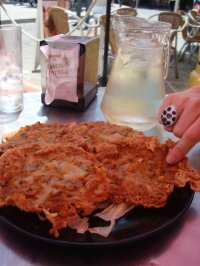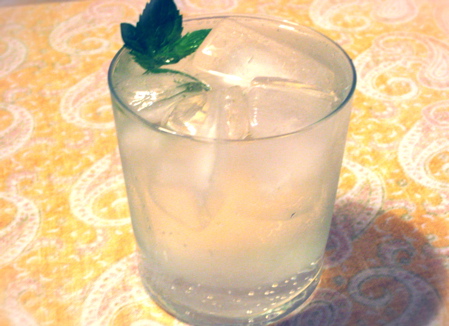
Teresa Parker blogs about restaurants, recipes, and the reasons why she's in love with Spain's food and culture.

"Oh, no, not me. I don't drink cocktails," I said, as Xesca mixed up a pitcher of rebujito, her favorite summer potion. "And especially not cocktails made of wine," I added snootily to myself. I mean, there's a reason spritzers are so 1970s, and that reason is wine. Yet here she was, a friend I truly admire, blithely swizzling up a bubbly drink with, of all things, a delicate Manzanilla.
Bone-dry and well-chilled Manzanilla is southern Spain's perfect cocktail all on its own. In fact, it would be the whole world's favorite aperitif if it weren't so misunderstood. You see, it's a sherry. If you're an American, that brings to mind white-haired ladies sipping sweet, warmish, tea-colored booze in a cobwebby drawing room in the vicinity of Harvard Yard. You would be wrong, of course.
My advice to purists ready to get to know the pleasures of dry sherry is pretty simple: buy a bottle of Manzanilla (perhaps La Guita from the Hijos de Rainiera Pérez Marín), get it good and cold (about 45 degrees F), and sip it with a bowl of salty marcona almonds, spicy garlic shrimp, or a sliver of good jamón Ibérico.
Like all sherries, Manzanilla is made by the solera method: each year's vintage is added to barrels racked at the top of the bodega as the year's bottling is drawn off from barrels at ground level (the suelo, thus solera), while, in between, the new and less recent vintages mingle.
As with all dry sherries, the barrels are filled only halfway. With other wines, barrels are topped up to prevent the wine being exposed to air. But with dry sherries, oxidization is prevented by a more magical process: a yeasty covering blossoms on the surface of the wine. The longer a wine spends under this creamy, foamy blanket of yeast, known as the flor, the drier, paler, and finer it becomes. That's why Manzanilla is finer than Fino: In Sanlúcar, where Manzanilla is made, local sea breezes support the flor year-round, plus, people say, they also impart a hint of saltiness to the wine.
So Xesca's rebujito cocktail is just so wrong, you're thinking. Well, I should warn you, Xesca is one of those Andalusians who is perfectly happy living in Barcelona. Her Catalan is just fine, but so is her flamenco. She says she doesn't really miss the South of Spain, but then she sneaks off to Jerez to the feria in spring. She is serious and not so serious at the same time. She is something of a seductress.
"Come on, mi amor, it's hot out. You'll see, a little rebujito is just the ticket," she says, pouring the icy, bubbly, minty, sherry potion into my glass. And it is.

El Rebujito, Según Xesca
for each cocktail
2 oz. well-chilled Manzanilla*
4 oz. cold tonic water**
1 large, leafy sprig fresh mint
plenty of ice
Pour the Manzanilla over ice and mint in a lowball glass, then add the tonic and give the mixture a quick stir.
Soon you'll be making these by the pitcher full -- just keep the proportions as they are here, and pour a round soon after mixing so as to take advantage of the tonic's bubbliness.
* Xesca insists on La Gitana brand because she is fond of the label – “es la más folklorica,” she says. Any Manzanilla or even a Fino will do.
** In Spain the mixer of choice would be La Casera, a gaseosa that is not quite as sweet as our tonic water. Some shameless expat drinkers substitute Sprite or Seven-Up, but doesn’t tonic seem classier?

Comments
Michele replied on Permalink
Sounds delicious, so I have to make it so that I can taste it too! Next week, we have friends from Australia coming to stay with us, so this will be a perfect time to try an El Rebujito!